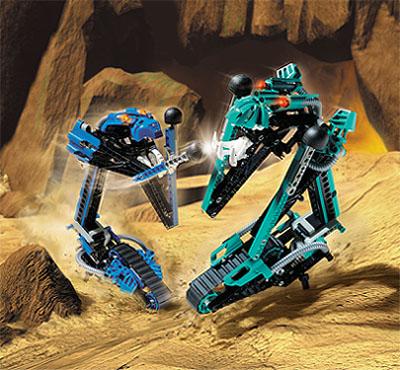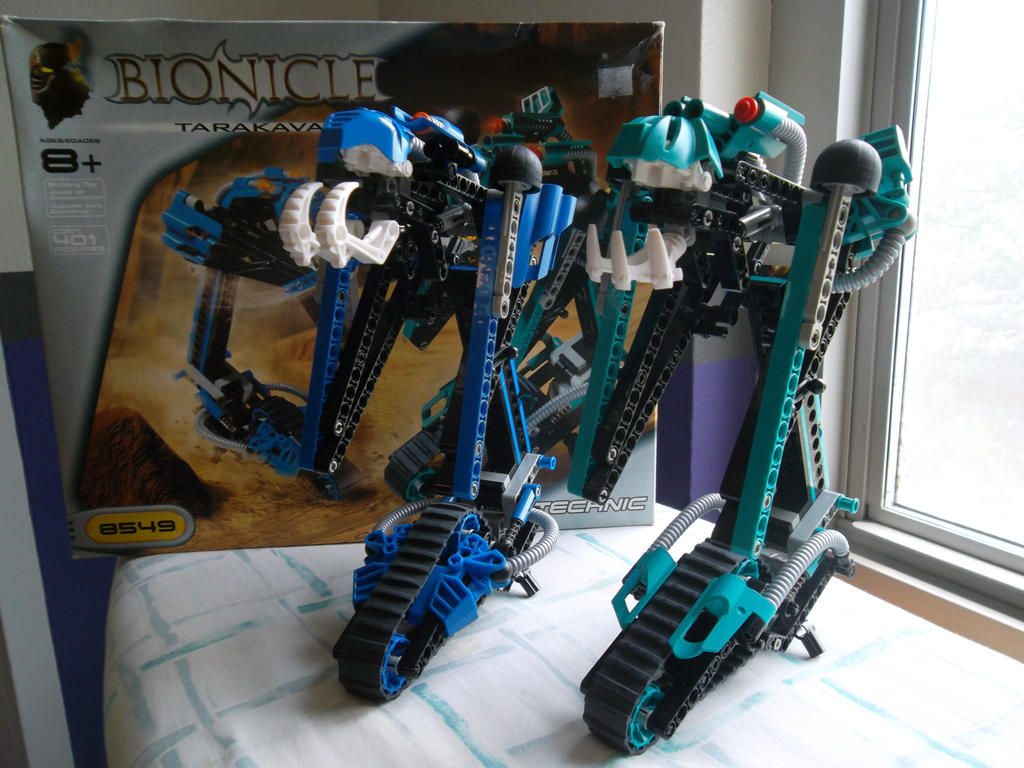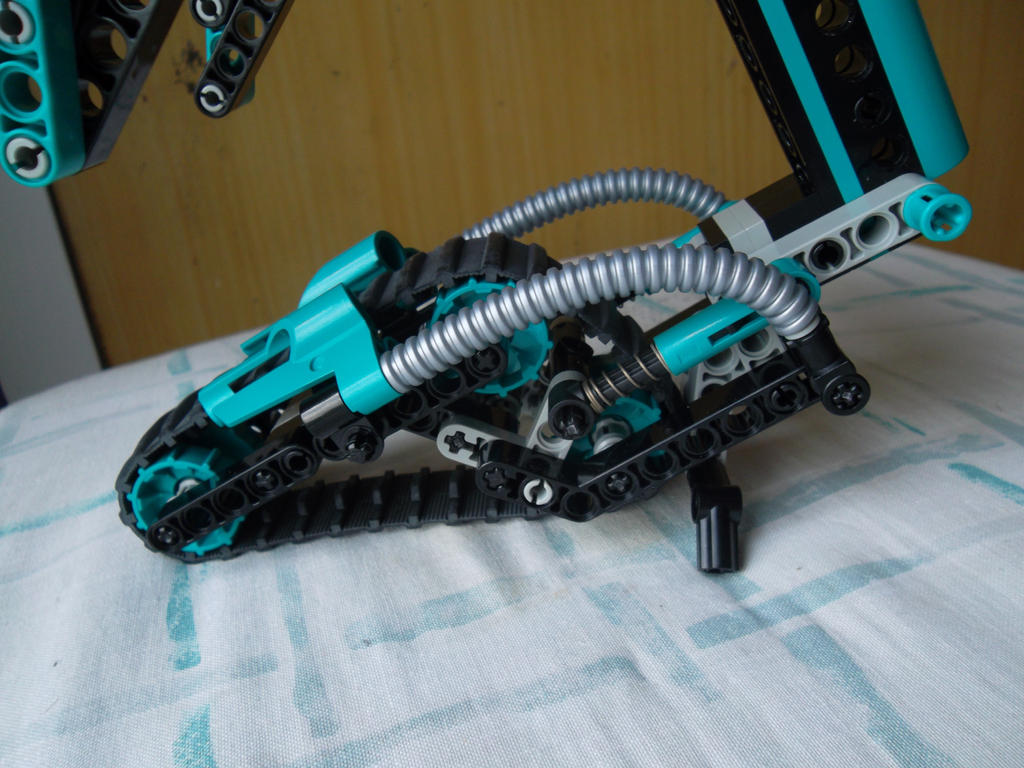![]() Big wall of text and pictures ahead!
Big wall of text and pictures ahead! ![]()
After recently coming into a massive early G1 haul, I found myself particularly impressed with the Bahrag Queens. I love the way in which they manage to blend form and function through Technic builds. This, in turn, led me to start looking at some other, more function-focused sets of yore, and I soon arrived at these guys:

Blue: “And now where’s the water, you fool!?”
Teal: “Sorry, we must’ve taken a wrong turn somewhere…”
The Tarakava. Punch-happy blue-and-teal G1 lizard monsters best known for terrorizing Ga-Koro in MNOG, they’ve often been characterized as “Rock’m Sock’m Rahi.” Having never played anything Rock’m Sock’m related, I decided to have a go at obtaining a set of them. Needless to say, this wasn’t cheap; all the Rahi sets seem to cost a pretty penny these days, and this one after shipping came down in excess of $80. On the plus side, that was with a sealed box and everything in it, like some sort of Bionicle time capsule.

No one has opened this box in over fifteen years…
The front of the box features what I assume is what a standard domestic argument among Tarakava looks like. Maybe one of them left the stove on, so now their Matoran’s overcooked… or they’re wondering how on Aqua Magna they ended up in a desert. They’re water creatures, darn it! Only the yellow ones roam the desert! Anyways… also prominently displayed on the front is the very old-school Bionicle logo, the Technic logo, piece count, age recommendations, the classic Hau-blended-with-aerial-view-of-the-island-of-Mata-Nui graphic, and a “building toy” in three different languages. Can’t be too sure…

Hey, I remember when Bionicle.com looked like that! Darn, I feel old…
The back features instructions on how to re-enact Tarakava arguments, complete with a graphic showing that their noses must be broken before you can knock their masks off. More on that later. Also displayed is the Tarakava Nui, which due to the unfortunate placement of the blue Pakari looks more like a derpy Boxor prototype on stilts at first glance. Rounding out the visuals is an advert for Bionicle.com, complete with screenshots of MNOG (I, not II), and bios for Pohatu, Toa of Stone and the island of Mata Nui itself. The most significant thing on the side of the box was a render of Tahu facing off against the blue Tarakava, which still wasn’t significant enough for me to remember to take a separate picture of it.
In all, in spite of having sustained some damage over the years, the box still looked the part of an '01 set on the shelf, its contents kept safe for years and years to make the whole thing worth $80 eventually. However, being of the opinion that Lego sets are meant to be built rather than just just kept under lock and key, I decided to relieve the contents of box of their hermetic isolation.

Box within a box! Box-ception!
Like some of the larger Rahi sets (apparently) the Tarakava come with a separate box within their box, allowing you to open it up like a drawer rather than just dumping the contents onto the table. It’s a nice feature, I suppose, though it can’t hold a candle to canisters for packaging coolness. Besides the Lego pieces, we get two instruction booklets and two smaller booklets advertising other Bionicle sets of the year with story details in four(!) different languages. They also present a couple of hard-to-find Technic sets and even some large Star Wars figures that came a long well before CCBS provided the means to make them properly, which shows.

Too early to feature the President Business Seal of Approval, but hey, instructions!.
The two instruction booklets each feature one Tarakava, which would seem superfluous these days. However, subtle differences in the builds of each Tarakava apparently necessitated it. The Teal Tarakava’s booklet also includes instructions on how to build the Tarakava Nui, which I would be inclined to do if I didn’t think it looked so incredibly silly in the pictures. There’s still time, though, so maybe someday… Anyways, let’s get around to building the actual set, shall we?
Greatly sped-up Tarakava building video set to music by Cryoshell:
The build of this set had a couple of very clever surprises in it, particularly the ‘suspension’ that allows the Tarakava to stand up straight or hunch forward, and the spring that allows the nose and jaws of the sets to lock in the up or down positions without risking them flopping about too loosely. Though there is some system involved in building their backs, this never felt much like anything other than a Technic build, even if the final result was something decidedly different than most Technic sets I’ve put together over the years. Though there are significant cosmetic differences between the two Tarakava beyond just their color, the working guts of the sets are identical, making the second one a bit of a deja-vu experience. Not nearly as bad as building Skopio’s legs, I can assure you.

Meet Wakkum and Stakkum, newly assembled Tarakava who have yet to learn that stargazing requires you look out of the building as opposed to into it.
Having completed both Tarakava and christened them Wakkum and Stakkum after two dwarves from a D&D campaign I’ve played in, I must admit that I’m very impressed with them. Their long, lanky construction means that they tower over basically any canister set barring some of the '08 Makuta, and in spite of only using one Kanohi each and a couple of old-school technic plates, they look quite cohesive and even give off a slightly organic vibe around the head. They’re really a master class in piece usage, I think; there’s not a single thing that, off the top of my head, I would add or remove to them that would make them look much better. Either way, looks are the only real difference between these two, so let’s examine them a little more detail.
Wakkum here is the Blue Tarakava, while Stakkum is the Teal one. When ‘at rest,’ the Tarakava look slightly upwards, though you can change the angle to make them lean forward when playing with them, which is fine. In spite of the fact that they were advertised as “lizard-like,” I’m seeing a lot more praying mantis here than any kind of lizard.


A wide head and broad, blunt snout give the blue Tarakava a more streamlined, shark-like appearance. The narrower, rougher build of the teal one evokes something more akin to a crocodile
Beneath the plates and masks, the heads of both Tarakava are identical. Note that, while the jaw can’t open or close on its own, the entire snout can be tipped down to expose the mask to being knocked off. a spring in the back of the Tarakava’s ‘throats’ ensures that, whether you want the nose up or down, it’ll stay there. The Gali hooks and Onua claw for the lower jaws are an interesting use of parts, though the mouth of the blue Tarakava can’t open far, while the mouth of the Teal one won’t close, which undercuts the appearance a bit. Really, how difficult would it have been to mount the hinges with friction pins?


Yellow knobs to indicate functions? What is this, 2015?
What system is featured in the Tarakava’s builds is used in the spine, which also functions as a handle if you’re more into smashing sets together than displaying them. The yellow handles are obvious as function indicators, but neither large nor protruding enough to break the flow of the set. Really, the function has been integrated beautifully here, which isn’t surprising since the set definitely gives the impression of being built around the function, rather than trying to cram the function into a specific appearance.


How are we supposed to use these for swimming, exactly?
Again, the foot assemblies are functionally identical, featuring a single tank tread for the Tarakava to roll around on and a kickstand for if you want them to sit still. Clever, integrated suspension mechanisms allow the entire top of the Tarakava to tilt forward, allowing them to either look up at the distant sky or down upon a puny Matoran who’s probably frightened out of their wits to be facing one of these. Really, I was surprised upon finishing them by how tall they actually are; they don’t have much volume to them, but they’ll tower over pretty much any other early Bionicle set other than maybe the Makuta himself.

For comparison’s sake, given that (so far as we know) none of these characters even exist in the same universe.
Toa Nuva can barely clear the lower jaw of the Tarakava, though 2015’s masters can stand up pretty even to them. Grievous of course stands over everyone and everything, as he should. In all, though, the Tarakava make Technic look good even against their more modern shelf companions. Also, unlike them, they’ve got a literal killer function:
The function is awesome. Really, this is the most fun I’ve had with a Bionicle set for quite some time; while the Masters and skull villains’ arm flailing had some merit as combining looking good with a function of sorts, the Tarakava prove that for a function to really be fun you have to go all-out with it. No swinging of puny blades, hammers and what have you; no, the Tarakava take the Mantis shrimp approach of simply punching things really hard until they die. In fact, given their appearance and function, I think “mantis shrimp” would be a far better description of these guys than “lizard.”
The outcomes, by the way? Well, Grievous did not survive that fall, and Onua may need to get fitted with some new armor…
Just as another testament to how much fun the Tarakava’s function is; I’ve been periodically picking them up while writing this review just to have them knock over all manner of random things on my desk. Really, nothing else in G2’s come close to that, and of the G1 sets that I have, only the Bahrag Queens are so much fun to actually, you know, play with. Of course, that does come at a price; apart from “jaw up, jaw down” the Tarakava have no posability whatsoever, and therefore have no real merit beyond their base appearance as display sets. Still, that appearance alone is worth considerable points with a healthy dose of nostalgia…
So, in light of that, it should come as no surprise that I rate this set very, very highly. Probably not quite $80 worth, but if you can find a complete pair for $60 or lower and are looking for a set that has great play value, you really can’t go wrong with these guys.




